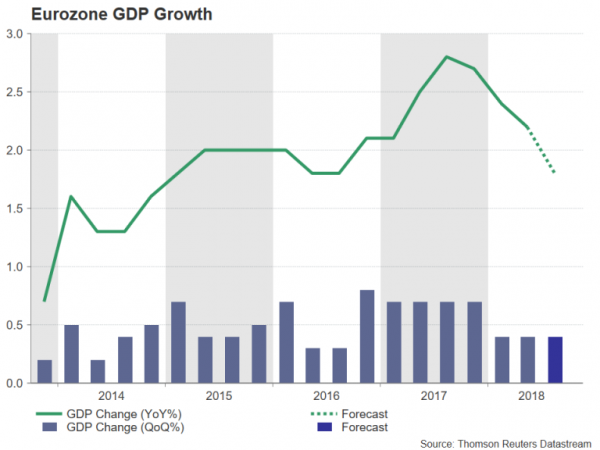There’s been little good news for the beleaguered Eurozone economy lately and GDP numbers due on Tuesday are not likely to change that trend. Eurostat will publish the euro area’s preliminary flash GDP estimates for the three months to September at 10:00 GMT, where another quarter of lacklustre growth is being predicted. The euro, which has been on a losing streak for the past month, is looking highly vulnerable to any disappointing readings.
Eurozone growth has been stuck in slow gear since the start of the year and a much-anticipated pick up in the second half doesn’t appear to have materialized. After notching up growth of 0.7% quarter-on-quarter throughout 2017, there’s been a significant loss of steam in 2018, with growth averaging 0.4% in the first half. While a strong euro and a cold winter held back growth in the first quarter, global trade tensions have dampened business confidence since the second quarter, with fears of an Italian crisis over the budget dispute with the European Union further undermining investor sentiment more recently.
The deteriorating outlook, which has coincided with slowing growth in most other parts of the world as well, has set the single currency on a downtrend even as the European Central Bank moves towards winding to a close its asset purchase program by year-end. Amid the weaker economic backdrop and uncertainty over Italy and Brexit, the euro is unlikely to find much respite from Tuesday’s GDP report.
The Eurozone economy is expected to have expanded by 0.4% q/q during the third quarter, unchanged from the prior period’s rate. On an annual basis, growth is projected to have slowed from 2.1% in the second quarter to 1.8% in the last quarter. Also due at the same time on Tuesday is the European Commission’s economic sentiment indicator (ESI). The index is forecast to moderate further in October, falling from 110.9 to 110.0 and down from its peak of 115.2 in December 2017.
While all eyes will be on the GDP figures, if the ESI points to a poor start to the fourth quarter, this could potentially exasperate any sell-off in the euro should the GDP data miss expectations. Euro/dollar would likely fall towards the August low of 1.1297, with a breach of this support clearing the path for the 1.1175 level – the 123.6% Fibonacci extension of the August-September upleg from 1.1297 to 1.1815. Further declines would bring into focus the 138.2% Fibonacci extension at the psychological 1.11 mark.
In the event of an upside surprise to the numbers, or in a more probable scenario that there is some positive aspect to the components of the data, traders could seek an excuse for a rebound. Any attempt for an upward push could see euro bulls stumbling near immediate resistance at just above the 1.14 handle, which is the 78.6% Fibonacci retracement. A successful break above this region would open the way for the 61.8% Fibonacci retracement at 1.1495. Higher up, an even bigger challenge could come from the 50% Fibonacci at 1.1556.
